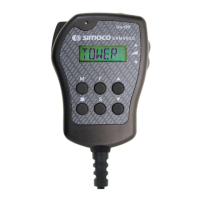SRM9020 ~ Trunked Operating Instructions
TNM-U-E-0012 Issue 2a Page 22 © Comgroup Australia 2010
APPENDIX C - GLOSSARY
A summary of common radio terms and some other terms used in this document,
and their meanings, are given below.
Alert Tones
The transceiver emits these tones to indicate an invalid operator
or error.
Cradle
The bracket that holds the microphone when it is not in use.
Control
Channel
A radio channel used for sending system information, SDMs, call
requests and signalling to send radios to traffic channels. Radios
listen to this channel when in Standby.
Dial String
A sequence of numbers that defines a call type and call address.
ESN
Electronic Serial Number. A factory programmed unique
hardware identity.
Fleet
A number of radios. Normally all radios owned by a user form a
fleet. A fleet is subdivided into groups.
FPP
Field Personality Programmer. PC based software, for
configuring a radio. Normally only used by trained personnel.
Group
A number of radios with the same group identity number,
normally organised into functionally related groups.
Handsfree
VOX
An optional function. The radio detects speech and controls the
transmitter, (Voice Operated Tx), to avoid the need to touch the
PTT switch whilst driving.
Identity
The unique number of a trunking radio. This is fully specified as
PREFIX/FLEET/UNIT NO.
In-Service
The radio has established communications with the trunking
structure and is able to make and receive calls.
LCD
Liquid crystal display.
MIC
Abbreviation for microphone.
MPT1327
Refers to the Radio Communications Agency specification
defining the low level protocol for public trunking systems.
MPT1343
Refers to the Radio Communications Agency specification
defining the User Interface for radios operating on MPT1327
public trunking systems.
Network
The trunking infrastructure and all its interconnections.

